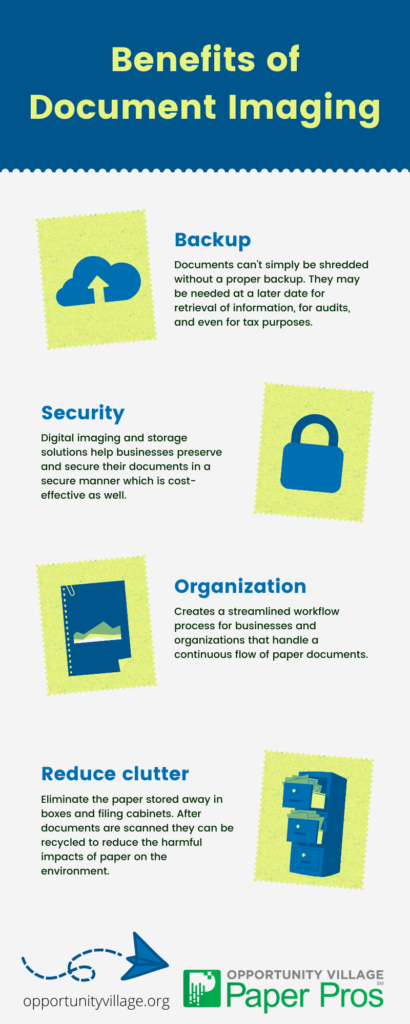
If you’re tired of looking around your office for important documents and files, and end up ruffling around a stuffy storage room through rows of filing cabinets, you may want to learn about document imaging.
It helps businesses save space, create secure backups of their files online, and make their documents more accessible.
Before asking how can you use document imaging, it’s worth figuring out what exactly document imaging is.
What is document imaging?
Document imaging is the process of converting a physical document into a digital file through electronic imaging or scanning. It involves capturing, storing, and retrieving documents in their original forms.
Document imaging allows users to scan, store, and sort a wide variety of document types, including paper documents, receipts, images, microfilms, maps, large-scale plots, and drawings as digital files.
These digital files can be stored in various formats across multiple devices to create a distribution of the document library that can be used in an electronic workflow for the organization. They can be backed up online and synced, so any changes made by one user can be observed and edited by another user as well.
Document imaging is perfect for forward-thinking organizations that want to digitize their workflow, eliminate physical storage of files and documents, and move towards a paperless office. Not only does it save storage cost and space, it’s also better for the environment, and significantly more efficient since a digital library of documents is more accessible and easier to browse through.
 Why is it important?
Why is it important?
If you have a business that creates hundreds of receipts, files, and paper documents each month, soon you’ll end up having thousands of old receipts, documents, files, maps, and even images lying around the office, or at best stored away in filing cabinets and boxes.
This creates a huge problem for any organization which needs to keep a record of its documents. Documents can’t simply be shredded or discarded without a proper backup. They may be needed at a later date for retrieval of information, for audits, and even for tax purposes.
This is where document imaging comes in. Document imaging converts paper documents into electronic files which can be backed up in an online database, a hard drive, a CD, or even a USB. These files can be stored without occupying valuable physical office and storage space. You can store millions of documents and images within a hard drive that’s smaller than your notepad.
Digital imaging and storage solutions help businesses preserve and secure their documents in a secure manner which is cost-effective as well. There’s also greater accessibility since documents can be indexed and sorted in a customizable manner.
Barcodes that contain metadata can be assigned to documents, and a barcode indexer can index them according to their metadata. This creates a streamlined workflow process for businesses and organizations that handle a continuous flow of paper documents.
Moreover, document imaging solutions allow offices to reduce the usage of paper in their documentation and eliminate the paper they have stored away in boxes and filing cabinets. After documents are scanned and indexed, they can be recycled to reduce the harmful impacts of paper on the environment, which also helps to minimize the carbon footprint of any company.
How can you use document imaging?
Document imaging can be used by corporations, businesses, and organizations to improve their workflow in a number of ways by using the following features:
Document imaging with OCR
Optical Character Recognition (OCR) is used to identify the text on any scanned documents and thus enables full-text search. Users can also assign metadata to index documents that are stored virtually.
Metadata
It allows users to search, browse, and procure digital files with great ease and efficiency. Custom metadata templates, fields, and reference numbers can be assigned to different types of documents for easier accessibility.
Metadata can be combined with barcodes for scanning documents and automatically categorizing them without need for manual input.
Document linking
Documents can be linked together using metadata, which makes it significantly easier to access related documents within a few clicks. Users can use this feature to cross-reference information from multiple documents and find any and all relevant information.
Document security
Document imaging systems can also apply various security features on different documents and folders within a database.
An organization can make it possible for only authorized users to access certain documents, and control the extent of access to certain functions as well. It can be programmed so some users can only view, whereas others can view, edit, and share files as well.
Version control
It allows users access to an audit trail that tracks who made the changes and what they were. A digital copy of each version is kept and is usually backed up online, so if needed, it can be restored or reverted to an older version.
All revisions and changes made to a document can easily be observed, including changes made to the document text itself, and its metadata.
Annotations
Simple graphical edits and comments can be added to documents with ease. This feature allows users to collaborate with other users while working on a document.
A number of annotation methods can be used, such as sticky notes, black-out redactions, stamps, photos, images, GIFs, bookmarks, and stamps. Redactions can be synced with security functions so they only reveal sensitive information to users that have access and clearance to those files.
Document imaging for a paperless office
Using a document imaging system is a step towards a paperless office which is not only beneficial for the environment but also creates an efficient workspace with a smoother, faster workflow. It allows quicker browsing through files, better collaboration between different users, and an overall increase in efficiency of a workspace.
If you think document imaging could streamline your business and are looking for a document imaging service provider, PaperPros may be your best.
We scan over 1.5 million documents each month, and offer a wide array of document imaging services with extensive functionality as well; such as content management software, data and document workflow, access & view functions, edits & annotations, reporting, auditing as well OCR and customized indexing for quick searches and easier browsing of documents.
For more information, contact Paper Pros.







